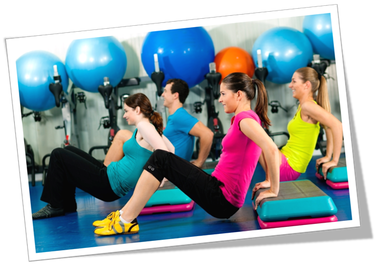 Is It Calisthenics or Plyometrics? Learn about Different Exercise Routines and How They Can Help You Reach Your Fitness Goals Ever wonder when you go to the gym what kind of exercise are you doing? Would you know if the group exercise class you have just completed was a cardio class or a circuit class? Knowing which exercise routine you are doing can help you target your fitness goals more effectively, all while reducing your chances of injuries. I put together the below list of all different types of training regimens, their benefits and popular examples. I hope you find it helpful with your fitness goals. Aerobic Exercises / Training:
They are also commonly known as “Cardio” exercises. These are exercises that are generally low in intensity and use large muscle groups rhythmically, for periods of 15 minutes or longer, while maintaining a heart rate of 50-70% of maximum heart rate (MHR). Benefit: Great for increasing endurance, heart strength and to help lose weight Examples: Walking, light jogging, swimming, and hiking Equipment: Not needed, but can be helpful (Treadmills, elliptical machines, stationary bikes and rowing machines) Anaerobic Exercises / Training: A brief (in short bursts) but intense form of training used by both athletes, to promote speed and power, and by bodybuilders to increase muscle mass. Muscles trained using anaerobic exercises develop differently than muscled trained with aerobic exercises and perform better in short but high intensity sports like sprinting. Duration usually ranges from a few seconds up to about 3 minutes. Benefits: Great for stamina, building muscle mass, increase bone strength and density Examples: Sprinting and weight lifting Equipment: Not needed, except for muscle training like weight machines and free weights Interval Training: It’s a form of training that combines low and high intensity of one exercise with short periods of rest in between. It can combine Aerobic and Anaerobic training to help get the benefits of both types of training. Benefit: Great way to spice up any training program. Excellent for improving cardiovascular fitness, stamina, and weight loss. Example: Intervals of walking and running, weight training with very heavy weights with active rest in between. Active rest can be in the form of stretching Equipment: Not needed High intensity Interval Training (HIIT): Same as Interval Training but with no rest in between the intervals. Circuit Training: This form of training gets mistakenly mixed with Interval Training. Circuit training is a type of strength training that uses several exercises arranged in an order or “stations”. Once one exercise is completed then you move on to the next, until you complete the whole circuit. Benefits: Time saver! Complete workouts can be done in relatively short periods of time Example: Upper Body Circuit Training – Bench dips, chest press, shoulder press, cable rows, and bicep curls Equipment: Weight machines, free weights and resistance cables Strength / Resistance Training: It’s training that uses resistance to challenge the muscles. Resistance can be external in the form of weights or resistance bands and internal in the form body weight. Benefits: Improvement in muscle strength and tone, stamina, and flexibility. It’s also great for better pain management, increased bone density, and posture improvement. Strength Training is also a great metabolism booster! Example: Weight lifting and calisthenics Equipment: machines are not needed but recommended for beginners. Other equipment include resistance cables / bands, dumbbells, sand bags, and kettlebells Calisthenic Exercises: Simply known as “Calisthenics” are strength training exercises that uses the body’s own weight as resistance. Benefits: Increased strength, endurance, stamina, and flexibility Example: Push-ups, pull-ups, dips, squats, lunges, and sit-ups Equipment: Not needed Isometric Exercises: A form strength training that challenges the muscles without the usual muscular contraction movement. In regular strength training, the muscles are challenged by the resistance through contractions (also known as the concentric phase - when the muscle is activated) and release (also known as the eccentric phase – when the muscle is relaxing and elongating). In isometric exercises, the muscle is challenged without actually moving any part of the body or altering the length of the muscle. The term “isometric” is actually two words: “Iso” which means “equal” and “metric” which means “length”. Benefits: Great for core strength Example: Plank and V-holds Equipment: Not needed Plyometric Exercises: Another type of strength training also known as “Jump Training”. Plyometrics is an intense form of strength training that involves rapid short muscle contractions followed by swift change in body movement or direction. Originally developed to increase muscular power and explosiveness of Olympic athletes, it became widely known and practiced with the increased popularity of military-style boot camps. Benefits: Great for improving power Example: Burpees and jumping squats Equipment: Not needed Cross Training: Training regimen that uses different modes of training (aerobic, anaerobic, strength, etc.) to develop a specific goal. Benefit: Performance improvement Example: Martial arts and military training Equipment: Not needed but can be helpful Fitness Boot Camp: It’s a type of indoor / outdoor group exercise class that is inspired by military-style training which mixes different type of exercises like interval training with Strength Training, Calisthenics, Plyometrics, and Isometric exercises. According to “World Wide Survey of Fitness Trends for 2013” – published in ACSM’s Health & Fitness Journal, boot camps ranked 16 in popularity in 2013. Benefits: Offers a different but more challenging workouts. Great camaraderie with other participants Example: Beach or garage boot camps Equipment: Not needed, but non-traditional items like sand bags, tires, and heavy manila ropes are used As always, please do not hesitate to reach me with any questions or comments. Happy Healthy Transformation! Your Trainer, Rami
0 Comments
Your comment will be posted after it is approved.
Leave a Reply. |
�
Topics
All
Guest ContributorsBuy Me Coffee |


 RSS Feed
RSS Feed

